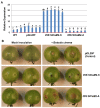Calmodulin Gene Expression in Response to Mechanical Wounding and Botrytis cinerea Infection in Tomato Fruit
- PMID: 27135512
- PMCID: PMC4844350
- DOI: 10.3390/plants3030427
Calmodulin Gene Expression in Response to Mechanical Wounding and Botrytis cinerea Infection in Tomato Fruit
Abstract
Calmodulin, a ubiquitous calcium sensor, plays an important role in decoding stress-triggered intracellular calcium changes and regulates the functions of numerous target proteins involved in various plant physiological responses. To determine the functions of calmodulin in fleshy fruit, expression studies were performed on a family of six calmodulin genes (SlCaMs) in mature-green stage tomato fruit in response to mechanical injury and Botrytis cinerea infection. Both wounding and pathogen inoculation triggered expression of all those genes, with SlCaM2 being the most responsive one to both treatments. Furthermore, all calmodulin genes were upregulated by salicylic acid and methyl jasmonate, two signaling molecules involved in plant immunity. In addition to SlCaM2, SlCaM1 was highly responsive to salicylic acid and methyl jasmonate. However, SlCaM2 exhibited a more rapid and stronger response than SlCaM1. Overexpression of SlCaM2 in tomato fruit enhanced resistance to Botrytis-induced decay, whereas reducing its expression resulted in increased lesion development. These results indicate that calmodulin is a positive regulator of plant defense in fruit by activating defense pathways including salicylate- and jasmonate-signaling pathways, and SlCaM2 is the major calmodulin gene responsible for this event.
Keywords: calcium signaling; jasmonic acid; plant defense; postharvest decay; salicylic acid.
Figures





Similar articles
-
Functional analysis of tomato calmodulin gene family during fruit development and ripening.Hortic Res. 2014 Nov 12;1:14057. doi: 10.1038/hortres.2014.57. eCollection 2014. Hortic Res. 2014. PMID: 26504554 Free PMC article.
-
Differential expression of calcium/calmodulin-regulated SlSRs in response to abiotic and biotic stresses in tomato fruit.Physiol Plant. 2013 Jul;148(3):445-55. doi: 10.1111/ppl.12027. Epub 2013 Feb 19. Physiol Plant. 2013. PMID: 23368882
-
SlERF2 Is Associated with Methyl Jasmonate-Mediated Defense Response against Botrytis cinerea in Tomato Fruit.J Agric Food Chem. 2018 Sep 26;66(38):9923-9932. doi: 10.1021/acs.jafc.8b03971. Epub 2018 Sep 18. J Agric Food Chem. 2018. PMID: 30192535
-
Inhibition of SlMPK1, SlMPK2, and SlMPK3 Disrupts Defense Signaling Pathways and Enhances Tomato Fruit Susceptibility to Botrytis cinerea.J Agric Food Chem. 2015 Jun 10;63(22):5509-17. doi: 10.1021/acs.jafc.5b00437. Epub 2015 May 28. J Agric Food Chem. 2015. PMID: 25910076
-
Mechanisms and strategies of plant defense against Botrytis cinerea.Crit Rev Biotechnol. 2017 Mar;37(2):262-274. doi: 10.1080/07388551.2016.1271767. Epub 2017 Jan 5. Crit Rev Biotechnol. 2017. PMID: 28056558 Review.
Cited by
-
Bioelectricity in dental medicine: a narrative review.Biomed Eng Online. 2024 Jan 3;23(1):3. doi: 10.1186/s12938-023-01189-6. Biomed Eng Online. 2024. PMID: 38172866 Free PMC article. Review.
-
A Plant Phytosulfokine Peptide Initiates Auxin-Dependent Immunity through Cytosolic Ca2+ Signaling in Tomato.Plant Cell. 2018 Mar;30(3):652-667. doi: 10.1105/tpc.17.00537. Epub 2018 Mar 6. Plant Cell. 2018. PMID: 29511053 Free PMC article.
-
Quantitative Phosphoproteomics of cipk3/9/23/26 Mutant and Wild Type in Arabidopsis thaliana.Genes (Basel). 2021 Nov 4;12(11):1759. doi: 10.3390/genes12111759. Genes (Basel). 2021. PMID: 34828365 Free PMC article.
-
Analysis of SSH library of rice variety Aganni reveals candidate gall midge resistance genes.Funct Integr Genomics. 2016 Mar;16(2):153-69. doi: 10.1007/s10142-016-0474-3. Epub 2016 Jan 22. Funct Integr Genomics. 2016. PMID: 26801786
-
Plant Roots Release Small Extracellular Vesicles with Antifungal Activity.Plants (Basel). 2020 Dec 15;9(12):1777. doi: 10.3390/plants9121777. Plants (Basel). 2020. PMID: 33333782 Free PMC article.
References
LinkOut - more resources
Full Text Sources
Other Literature Sources

